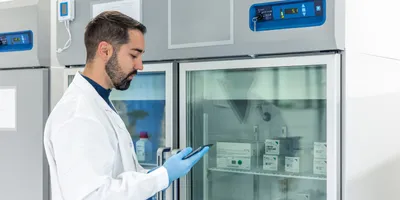Raymond Almgren, CEO of Swift Sensors, discusses how temperature tracking is shifting from isolated tasks to integrated systems, with lasting effects on lab oversight.
Q: Why do so many labs still rely on manual temperature checks?
A: Most labs don’t make a change until there’s a forcing function: losing samples, failing an audit, some event that pushes the issue. Until then, the cost of manual work goes unnoticed because the team is busy fighting other fires.
I was at a clinic getting blood drawn and noticed a temperature monitor on the fridge. I asked the tech if they tracked temps and followed CLIA requirements—he said yes. But when I asked if they’d thought about automating it, he hadn’t. That’s the issue. It’s perception. People think automation is hard, complicated, expensive. It’s our job to show them it’s not.
Q: Where do the real costs of manual checks show up?
A: It’s staff time, mostly. Someone’s walking around, writing things down, maybe typing it in later, maybe not. And the bigger hit is you only learn about problems after they happen. If something goes out of range overnight, you might not know until the next morning. Then during an audit, someone’s scrambling to pull all the records together. With wireless sensors feeding a cloud dashboard, the report’s already there. You don’t have to chase paperwork.

Raymond Almgren
Q: How does wireless temperature monitoring change the situation?
A: First, you don’t have to run wires throughout the building. I’ve been in hospitals where the temperature-monitoring wiring rivals Ethernet or the old phone cable bundles. Wireless eliminates all that. It reduces cost and lets you add a new sensor quickly, even for something you hadn’t planned for. You don’t have to hunt for an open port or run new cable.
And you can move equipment without hassle. If a freezer needs to shift rooms, the sensor goes with it. There’s nothing to rewire, and nothing to slow you down.
Q: What makes a cloud-based system easier to manage than local software?
A: You don’t have to maintain a local PC or server, or deal with OS patches or software updates. The cloud dashboard runs on any phone, tablet, or desktop, with updates and user settings handled automatically.
The system supports different levels of access. A technician can view just their assigned equipment, while operations or quality can see the full network. That flexibility really matters once the system scales.
Q: Can labs use their existing probes with wireless sensors?
A: In many cases, yes. Our wireless loggers work with standard temperature probes such as thermocouples, thermistors, and resistance temperature detectors. It’s a straightforward retrofit, and we provide adapters if needed.
That’s especially important with cold storage. You don’t want to warm up a liquid nitrogen freezer just to swap out a sensor. If the probe’s already in place and calibrated, you leave it alone. Just connect the new logger and keep running.
Q: What does rollout look like for a full lab?
We’ve done full conversions in a day for smaller labs. Setup is simple: plug in the gateway, drop in the sensors, and go live. But even quick installs need IT on board. If the system touches the network, security policies apply. The smoothest rollouts happen when the lab and IT teams coordinate from the start. The messy ones don’t.
Our largest rollout went to a major cancer center with roughly 3,500 endpoints, including freezers, incubators, and bioreactors. Their wired system still worked, yet service fees kept climbing, so they moved to our wireless platform. Even with their spiral-bound compliance setup, our system covered nearly all their needs at a much lower cost.
Lab staff led the deployment. They placed gateways in hallways and added sensors one lab at a time. The IT group built dashboards for each department and trained local leads. They remain our most demanding customer, but their feedback makes the platform better.
Q: When does it start paying back?
A: Most labs see a return within the first year. That cancer center cut hundreds of thousands in service contracts, hardware costs, and monitoring labor. Smaller labs may save less in absolute terms, but the benefits show up quickly: fewer missed alarms, less audit stress, and more confidence in the data. You stop babysitting the equipment and start trusting the system.
Q: Why treat sensor data as infrastructure rather than just compliance?
A: Once the data is in the cloud, it connects to more than just reports. Labs can link it to ticketing systems, maintenance tools, even energy monitoring platforms. That’s already happening. We integrate with ticketing software. In airports, our sensors trigger dispatch for elevator techs. Hospitals are beginning to do the same with lab equipment. The value isn’t in the sensor. It’s in what you can connect to it.
We’re not an AI company. But nothing stops an AI company from using our data to build predictive models or smarter alerts. That’s what a real cloud platform makes possible. It creates a space where other systems can plug in. Competitors work together. Partners build on each other. The result is more useful data and better outcomes. We’ve already seen this with self-driving cars: connected inputs, shared logic, and decisions made in real time. Labs are moving the same way.
Q: What does the next generation of wireless monitoring look like?
A: More data, longer battery life, and smarter analytics. The latest low-power radios can stream ten times more data without draining the battery. And as more sensor types come online—temperature, humidity, vibration—you get closer to sensor fusion. That’s when systems stop reacting and start anticipating.




